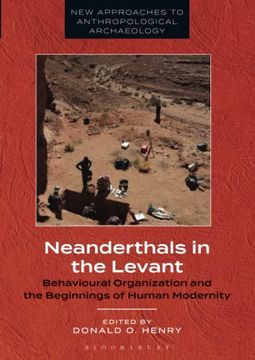Compartir
Neanderthals in the Levant: Behavioural Organization and the Beginnings of Human Modernity (New Approaches to Anthropological Archaeology) (en Inglés)
Henry Donald O. (Autor)
·
Bloomsbury Academic
· Tapa Blanda
Neanderthals in the Levant: Behavioural Organization and the Beginnings of Human Modernity (New Approaches to Anthropological Archaeology) (en Inglés) - Henry Donald O.
S/ 177,79
S/ 355,58
Ahorras: S/ 177,79
Elige la lista en la que quieres agregar tu producto o crea una nueva lista
✓ Producto agregado correctamente a la lista de deseos.
Ir a Mis Listas
Origen: Estados Unidos
(Costos de importación incluídos en el precio)
Se enviará desde nuestra bodega entre el
Viernes 26 de Julio y el
Martes 06 de Agosto.
Lo recibirás en cualquier lugar de Perú entre 2 y 5 días hábiles luego del envío.
Reseña del libro "Neanderthals in the Levant: Behavioural Organization and the Beginnings of Human Modernity (New Approaches to Anthropological Archaeology) (en Inglés)"
This significant contribution to scholarship on the Middle Paleolithic, now reissued with a new preface, traces the controversy that revolves around the bio-cultural relationships of Archaic (Neanderthal) and Modern humans at global and regional, Levantine scales. The focus of the book is on understanding the degree to which the behavioral organization of Archaic groups differed from Moderns. To this end, a case study is presented for a 44-70,000 year old, Middle Paleolithic occupation of a Jordanian rockshelter.The research, centering on the spatial analysis of artifacts, hearths and related data, reveals how the Archaic occupants of the shelter structured their activities and placed certain conceptual labels on different parts of the site. The structure of Tor Faraj is compared to site structures defined for modern foragers, in both ethnographic and archaeological contexts, to measure any differences in behavioral organization.The comparisons show very similar structures for Tor Faraj and its modern cohorts, and the implications of this finding challenge prevailing views that Archaic groups had inferior cognition and less complex behavioral-social organization than modern foragers. The study also calls into question the contention that such behaviors only emerged after the appearance of the Upper Paleolithic, dated some 10-20,000 years later than the occupation of Tor Faraj.
- 0% (0)
- 0% (0)
- 0% (0)
- 0% (0)
- 0% (0)
Todos los libros de nuestro catálogo son Originales.
El libro está escrito en Inglés.
La encuadernación de esta edición es Tapa Blanda.
✓ Producto agregado correctamente al carro, Ir a Pagar.

